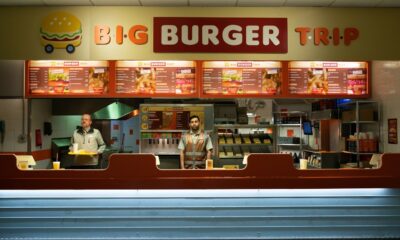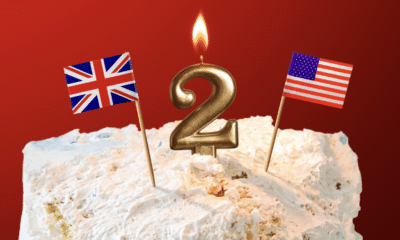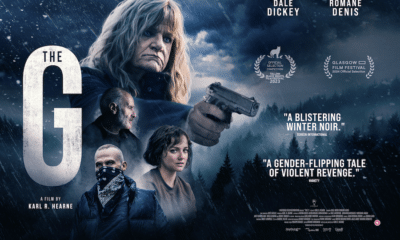“This is the decade in which London will become Europe’s capital.” – Harold Shand, The Long Good Friday.

Arrow Video/YouTube
In 1979, a new British feature went into production under the title ‘The Paddy Factor’. The film, scripted by London-born writer Barrie Keeffe would help define a genre, give legendary actor Bob Hoskins one of his first major movie roles, feature a future 007, and would also predict the commercial and corporate future of an area of east London.
The events of The Long Good Friday take place on the annual Easter holiday during Thatcher’s reign as Prime Minister. The main protagonist is Bob Hoskins’ Harold Shand, a ‘freewheeling, capitalist developer’ – and head of an underworld corporation – who is about to make the deal of the century. He’s just landed, via Concord, of course, back in the UK after a successful trip across the pond in the United States where he has managed to secure the attention of a big-time connection – mafia man Charlie (Eddie Constantine). Charlie is about to land in the UK as a guest of Shand, who hopes to get him to sign on the dotted line to enter a partnership to develop an area of London’s Docklands – an area which would eventually become Canary Wharf – we’re talking shops, hotels, casinos and a thriving business hub.
Things start off well, Shand hosting a glamourous reception on a Thames river boat, but as the ‘Long Good Friday’ of the title progresses, a series of events unravel that not only jeopardise the big deal with his American friends, but also his life and all of those around him.
“Bob Hoskins sadly passed away in 2014, but his legend lives on in this, in my opinion, his finest hour.”
Prior to filming The Long Good Friday, Hoskins was already a name that most knew. He was coming off a huge television series, Dennis Potter’s Pennies From Heaven, which aired on British television in 1978. There was also the feature Zulu Dawn, a prequel to the hugely successful Zulu, in which Hoskins played the role of C.S.M. Williams, a high-ranking NCO in the British forces. Hopkins was reportedly infected with a 40-foot tape in Africa, and was reportedly offered the role of Shand while he was still in a London hospital bed recovering. Thankfully, it didn’t stop him from taking the part.
Alongside him in the film is a superb Helen Mirren in the role of Victoria, Shand’s right-hand woman – though more than your typical gangster’s moll. There’s also an appearance from future James Bond, Pierce Brosnan – seen on screen as an Irish assassin. His presence in the film is limited, but the character, credited as ‘Irishman No. 1’ is key to the plot, book-ending the film and the man who would seal Shand’s fate on that fateful car journey around London’s West End.
Acclaimed British actor Paul Freeman (Raiders Of The Lost Ark) plays Colin, one of the first to meet his maker early on – also at the hands of Brosnan’s hitman – a scene filmed in Morden swimming baths, while Derek Thompson plays the central role of Jeff, right-hand man and the son-figure of Hoskins’ Shand.
Also look out for:
- PH Moriarty (as Razors) and Alan Ford (as Shand’s associate Jack) – who would go on to play the villain roles in Guy Ritchie’s Lock Stock and Two Smokin’ Barrels and Snatch respectively, some decades later.
- Rocketman and Eddie The Eagle director Dexter Fletcher as a young boy looking after Shand’s car as he goes about his business.
Hoskins is perfect in the role of Shand – a role he was seemingly born to play after growing up in and around the capital. In an interview on the recent home release, the actor says, “The character [of Harold Shand] was me, apart from being a gangster.”
“[He’s] emotional, climbing up the tree in his profession.” A patriot, Shand, as described by director John Mackenzie on the recent Blu-ray ‘making-of’, is labelled as a patriot, and a man who is tender and loving one minute – and the next an absolute monster.
“People though about me in a different way after that film,” said Hoskins in an archive interview on the same featurette.
The film was shot mostly on location all over London. The famous pub where the second bombing was staged was a set, constructed from scratch at the end of a long road so that the point of view from the passengers from inside the car that carries Shand and Victoria couple be captured on film. Another iconic scene – one staged in an abattoir saw a group of villains suspended from their ankles as they were interrogated by Shand and his henchmen. Them hanging upside-down was reportedly Hoskins’ idea.
The film is, quite simply, one of the best gangster movies to have ever come out of the UK. It is superbly directed by Mackenzie, features some career-best performances, particularly from the loved and cherished national treasure in Hoskins, and some wonderful cinematography from Phil Méheux– the man who would go on to shoot the likes of Who Dares Wins, The Fourth Protocol and no less than two James Bond movies – one with Brosnan (Goldeneye), and another with Daniel Craig for the franchise rebirth that was Casino Royale in 2006.
A key scene to showcase the absolute genius at work from Hoskins, Mackenzie and Méheux is one that is perhaps the most important one in the movie – the confrontation of Jeff in the final reel. The behind the scenes feature on the Blu-ray release (which we reviewed in detail here) reveals that Méheux was given freedom to hand-hold the camera as we follow Shand onto the boat – the setting for the big moment in the movie. Meheux reveals that he had to control the exposure, the movement, the focus and the framing of the show himself – working in a confined space alone with Hoskins. Later in the scene, after the arrival of Jeff, Méheux’s camera allows Hoskins to move in the frame to wherever he likes, the cinematographer and his director employing the use of a wide-angled lens, capturing the build-up of drama and the brilliance of Hoskins’ acting perfectly. It is a masterclass in filmmaking.
The climactic scene, the one set outside the Savoy hotel in The Strand in London sees Shand finally caught by the IRA and features a lingering shot on Hoskins’ face as he slowly things about how he is going to escape capture, through to ultimately accepting his fate. The climax, reportedly shot very early during production, was done with director Mackenzie driving the car whilst directing Hoskins at the same time – going through the character’s thought process as the vehicle speeds away from the luxury Savoy hotel.
After shooting was completed, the film hit some roadblocks in terms of release, but was eventually sold to George Harrison’s Handmade Films. In February of 1981, it finally bowed in cinemas to a rapturous reception from both critics and cinema-goers. It was the breakthrough film for Hoskins, who would go on to have a huge career both in his homeland and on the world stage, including Hollywood.
The actor sadly passed away in 2014 at the age of 71. The Long Good Friday is just one of the films he will be remembered for, and over the years would appear in the likes of Mona Lisa, Brazil, Steve Spielberg’s Peter Pan movie Hook, and of course Robert Zemeckis’ Who Framed Roger Rabbit?, winning over millions of fans in the process.
Hoskins is missed, but his work lives on. The Long Good Friday displays the actor at his best, a prophetic feature that remains relevant and timeless some 40 years on. If you haven’t seen it – take some time over the holiday break to rectify that. It really is one of British film’s finest hours.
The Long Good Friday is currently available on Blu-ray from Arrow Video.

Latest Posts
-


Film News
/ 2 days agoRelease date announced for sci-fi drama ‘Sky Peals’
A UK release has been announced for Sky Peals following a debut on the...
By Paul Heath -


Amazon Prime
/ 2 days agoAmazon’s ‘Red, White & Royal Blue’ with Nicholas Galitzine and Taylor Zakhar Perez is getting a sequel
Ahead of Amazon’s inaugural upfront presentation on May 14, Amazon MGM Studios has confirmed...
By Paul Heath -


Home Entertainment
/ 2 days agoApplauded ‘Snack Shack’ set for home debut in June
Snack Shack has had a home release date set for June in the UK....
By Paul Heath -


Film News
/ 2 days agoRelease date set for brilliant drama ‘The G’ with Dale Dickey
A release date for the brilliant crime drama The G has been set by...
By Paul Heath














